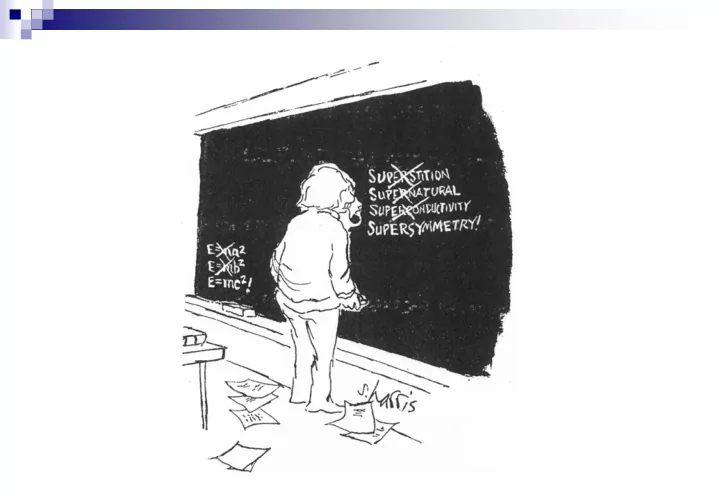

New Developments in Nuclear Supersymmetry Roelof Bijker ICN-UNAM Mexico bijker@nucleares.unam.mx José Barea Alejandro Frank Jan Jolie (Köln) Gerhard Graw (München)
The Nuclear Many-Body Problem � Ab initio methods: GFMC, NCSM, CCM, … � Effective field theory � Shell model: Monte Carlo, continuum SM, … � Mean-field methods: DFT, QRPA, HFB, GCM, … � Phenomelogical models of collective motion: IBM and its extensions, … � Dynamical (super)symmetries � …
Motivation � Large scale calculations Ab initio Shell model Mean field � Symmetry methods IBM and IBFM with isospin Nuclear supersymmetry
I am very happy to learn that the computer understands the problem, but I would like to understand it too Eugene Wigner
Motivation � What are the “effective” degrees of freedom? � Are there “effective” symmetries? � Symmetries provide benchmarks � Examples: special solutions to the Bohr Hamiltonian, dynamical symmetries of the IBM, pseudo-spin symmetries
Smaller and smaller M.C. Escher
Outline � Introduction � Interacting boson models � Dynamical supersymmetries � Heavy nuclei: the A ∼ 190 mass region � Light nuclei: sd- and pf-shell � Summary and conclusions
Symmetries � Geometric symmetries Buckyball with icosahedral symmetry � Permutation symmetries Fermi-Dirac and Bose-Einstein statistics � Space-time symmetries Rotational invariance in nonrelativistic QM, Lorentz invariance in relativistic QM � Gauge symmetries Dirac equation with external electromagnetic field
Dynamical Symmetries � Hydrogen atom (Pauli, 1926) � Isospin symmetry (Heisenberg, 1932) � Spin-isospin symmetry (Wigner, 1937) � Pairing, seniority (Racah, 1943) � Elliott model (Elliott, 1958) � Flavor symmetry (Gell-Mann, Ne’eman, 1962) � Interacting boson model (Arima, Iachello, 1974) � Nuclear supersymmetry (Iachello, 1980)
Interacting Boson Model � The IBM describes collective excitations in even-even nuclei in terms of a system of correlated pairs of nucleons with angular momentum L=0 and L=2 which are treated as bosons (s and d bosons) (Arima and Iachello, 1974) � The number of bosons N is half the number of valence nucleons � Introduce boson creation and annihilation operators which satisfy the commutation relations
Shell structure: valence nucleons Cooper pairing: s, d boson system Collective motion: nuclear shapes
Dynamical Symmetries Schematic Hamiltonian :
Nuclear Supersymmetry � Consider an extension of the IBM which includes, in addition to the collective degrees of freedom (bosons), single- particle degrees of freedom of an extra unpaired proton or neutron (fermion with angular momentum j=j 1 , j 2 , …) � For the extra nucleon, introduce fermion creation and annihilation operators satisfy anticommutation relations
Building Blocks
Algebraic Structure Supersymmetry: the total number of bosons AND fermions is conserved
Hamiltonian
Examples
Supersymmetry in Heavy Nuclei Neutron levels Proton level
Even-even nucleus Cizewski et al, PRL 40, 167 (1978) Arima, Iachello, PRL 40, 385 (1978)
Odd-proton nucleus Iachello, PRL 44, 772 (1980)
Odd-neutron nucleus Balantekin, Bars, Bijker, Iachello, PRC 27, 1761 (1983)
Supersymmetric Quartet of Nuclei Neutron-proton SUSY : Van Isacker, Jolie, Heyde, Frank, PRL 54, 653 (1985)
Group chain
Hamiltonian Energies
Odd-odd nucleus Metz et al, PRL 83, 1542 (1999)
One-proton transfer Test of the fermionic generators of the superalgebra ! Barea, Bijker, Frank, JPA 37, 10251 (2004)
Correlations
Correlations � One-proton transfer reactions � One-neutron transfer reactions
Two-nucleon transfer Reaction Spectroscopic factors Relative strength
Barea, Bijker, Frank, PRL 94, 152501 (2005)
Supersymmetry in Light Nuclei Pseudo sd-shell Pseudo-SU(4) symmetry Van Isacker et al, PRL 82, 2060 (1999) sd-shell Wigner SU(4) symmetry
Interacting Boson Models � Heavy nuclei: protons and neutrons in different major shells � Light nuclei: protons and neutrons occupy same major shells ⇒ isospin invariant IBM Elliott, White, PLB 97, 169 (1980) Elliott, Evans, PLB 101, 216 (1981)
Dynamical Supersymmetry
Example in the sd-shell Szpikowski et al, NPA 487, 301 (1988)
Example in the pf-shell Van Isacker et al, PRL 82, 2060 (1999) R. Bijker, Ph.D. Thesis, 1984
Magic mirror M.C. Escher
Summary and Conclusions � Nuclear supersymmetry: energy formulas, selection rules, transition rates, etc. � Supersymmetry leads to correlations between different transfer reactions � Applications in both heavy and light nuclei � Proton-rich nuclei: dynamical (super)symmetries of isospin invariant IBM and IBFM? � Neutron-rich nuclei: are there additional degrees of freedom (valence protons, valence neutrons, skins), what are the corresponding symmetries? � SUSY without dynamical symmetry � Predictability
Recommend
More recommend